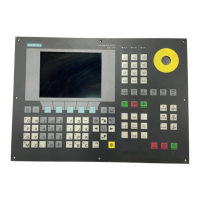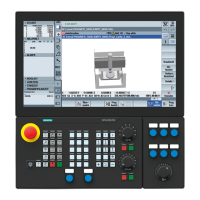W1: Tool offset
18.6 Toolholder with orientation capability
Basic Functions
Function Manual, 09/2011, 6FC5397-0BP40-2BA0
1523
Toolholder kinematics
The following supplementary conditions must be met for toolholder kinematics:
• Tool orientation in initial state, both angles α
1
and α
2
zero, as per default setting, even if:
- G17 parallel to Z
- G18 Parallel to Y
- G19 parallel to Z
• A permissible position in terms of the axis limits must be achievable.
• For any possible orientation to be set, the two rotary axes must be perpendicular to each other.
For machines, on which the table is rotated by both axes, the tool orientation must also be perpendicular to
the first rotary axis.
For machines with mixed kinematics, the tool orientation must be perpendicular to the axis, which rotates the
tool, i.e., also the first rotary axis.
The following applies to orientations specified in a frame:
• The orientation specified in a frame must be achievable with the defined toolholder kinematics, otherwise an
alarm is output.
This situation can occur if the two rotary axes required to define the kinematics are not perpendicular to each
other.
This applies if fewer than two rotary axes are defined and is the case:
-With kinematic type T with rotary tool, if the tool axis, which defines the tool direction, is not perpendicular
to the second axis.
-With kinematic types M and P with rotary workpiece, if the tool axis, which defines the tool direction, is not
perpendicular to the first axis.
• Rotary axes, which require a frame with a defined tool orientation in order to reach a specific position, are only
determined unambiguously in the case of one rotary axis. Two general solutions exist for two rotary axes.
• In all cases where ambiguities may arise, it is particularly important that the approximate angles expected
from the frame are stored in the tool data, and that the rotary axes are in the vicinity of the expected positions.
Response with ASUP, REPOS
The toolholder can be changed in an asynchronous subprogram (ASUB). When the interrupted program is
resumed with REPOS, the approach motion of the new toolholder is taken into account and the program continues
with this motion. The treatment here is analogous to tool change in an ASUB.
References:
/FB1/ Function Manual Basic Functions; Mode Group, Channel, Program Operation, Reset Response (K1)

